|
[ Section Amanita page. ]
[ Amanita Studies home. ]
[ Keys & Checklist/Picturebooks ] "American Eastern Yellow Fly Agaric" =Amanita muscaria var. formosa sensu auct. amer. orient.
Technical description (t.b.d.) BRIEF DESCRIPTION: Amanita muscaria var. guessowii is the common, bright yellow and/or yellow and orange fly agaric of eastern North America. The European name A. muscaria var. formosa Pers. has been mistakenly applied to this taxon. Some macroscopic dimensions in the following are taken from (Jenkins, 1977).
The gills are narrowly adnate, subcrowded to crowded, cream in mass and pale cream to cream in side view (with no observed staining or bruising reaction), with breadth 7.5 - 9+ mm. The short gills are truncate, unevenly distributed, of diverse lengths, and plentiful. The 60 - 150 x 6 - 21 mm stem (length includes a notable basal bulb) is white to yellowish cream to pale yellow and annulate and usually narrows upward and flares at the top. The stem surface is pulverulent above the ring and coarsely shaggy to fibrillose and longitudinally finely striate, below. The stem is stuffed in its 4+ mm wide central cylinder with densely packed white material (fibers of which have longitudinal orientation). Tunnels of insect larvae through the flesh become yellow-brown. The ring is membranous, persistent, skirt-like, and located on the upper part of the stem; it may bear numerous warts from the internal limb of the volva on the underside of its free edge. The upper side of the ring is often not striate, and the underside is often pulverulent. The basal bulb is subglobose to subovoid and 20± x 21± mm. The lower stipe and upper bulb are decorated with partial or complete rings of volval material as in the type variety. The volval material ranges from bright pale yellow to cream to sordid cream. Notice (for example, in some images above) that the volval material on the stipe base may also take a form reminiscent of the volva of species such as A. pantherina (DC. : Fr.) Krombh., A. albocreata G. F. Atk., A. multisquamosa Peck, or A. velatipes G. F. Atk. The spores measure (7.0-) 8.7 - 12.2 (-14.8) x (5.9-) 6.5 - 8.2 (-9.5) µm and are broadly ellipsoid to ellipsoid (infrequently subglobose or elongate) and inamyloid. Clamps are present at bases of basidia.
This variety apparently contains the same toxins as Amanita muscaria (L. : Fr.) Lam. subsp. muscaria of Europe, northern Asia, and far northwestern North America (western Alaska). With the recent large increase in immigration from Mexico into the eastern half of the U.S., we have seen an increase in poisonings by var. guessowii because it is mistaken for the edible Amanita basii Guzmán & Ramírez-Guillén (until recently, called "Amanita caesarea" by Mexican authors). When diagnosing the poisoning by questioning a Spanish-speaking victim, it is important not to simply translate "amarillo" as "yellow." One of the common names of Amanita basii in Mexico is "amarillo." A poisoning victim recently immigrated from Mexico to the eastern U.S. may be conveying the name of the mushroom by the word "amarillo," not just the color of it. Amanita muscaria var. guessowii is associated primarily with conifers, but can occur with deciduous tree genera as well. It often occurs in the Fall in the mid-Atlantic states of the U.S., but it may appear as early as May in years with plentiful Spring rains. The northern limit of the range of this taxon is north of the Isl. of Labrador and central Quebec. The southern limit is not clear to me, but the range certainly includes the central Appalachian region. Other American taxa currently treated as varieties or subspecies of A. muscaria are A muscaria var. alba Peck, A. muscaria var. persicina Dav. T. Jenkins, and A. muscaria subsp. flavivolata Singer -- R. E. Tulloss Photos: R. E. Tulloss (first row, Massachusetts, USA; second row, Isl. of Newfoundland, Canada; next two rows & first image in text, New Jersey, USA; second image in text, Prov. Québec, Canada).
[ Section Amanita page. ]
[ Amanita Studies home. ]
[ Keys & Checklist/Picturebooks ] Last changed 10 October 2009. |
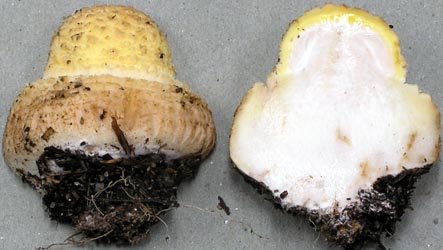
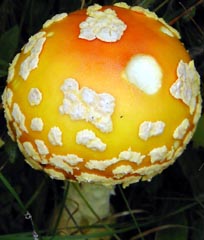

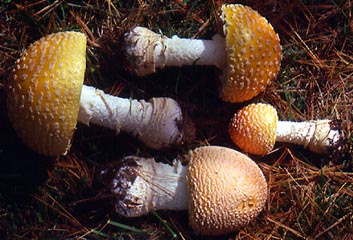
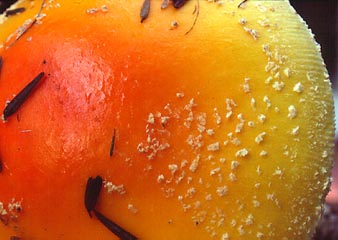
 Its cap is 45 - 180 mm wide. The pigment may wash out in
rain or fail to develop under detritus if the latter
covers a large part of the cap. The volva is distributed
over the cap as cream to pale tan warts that tend to
become somewhat sordid with age. The cap margin often
becomes striate at maturity or in age. The context of the
cap does not stain when cut or bruised.
Its cap is 45 - 180 mm wide. The pigment may wash out in
rain or fail to develop under detritus if the latter
covers a large part of the cap. The volva is distributed
over the cap as cream to pale tan warts that tend to
become somewhat sordid with age. The cap margin often
becomes striate at maturity or in age. The context of the
cap does not stain when cut or bruised.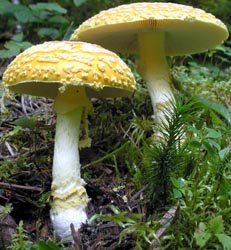 This
taxon can be found rather commonly in the boreal forests of eastern
Canada (personally observed in Prov. Québec and on the Island of
Newfoundland). Its range extends considerably further to the
west and south. It is probably limited by the Great Plains of
the central USA [the westernmost state cited in the variety's range by
Jenkins (1986) is Michigan]. The present taxon is known at least
as far south as the central Applachian mountains (in North Carolina
and Tennessee). Dried and annotated material from outside the
above stated limits of distribution is very much desired by the author.
This
taxon can be found rather commonly in the boreal forests of eastern
Canada (personally observed in Prov. Québec and on the Island of
Newfoundland). Its range extends considerably further to the
west and south. It is probably limited by the Great Plains of
the central USA [the westernmost state cited in the variety's range by
Jenkins (1986) is Michigan]. The present taxon is known at least
as far south as the central Applachian mountains (in North Carolina
and Tennessee). Dried and annotated material from outside the
above stated limits of distribution is very much desired by the author.